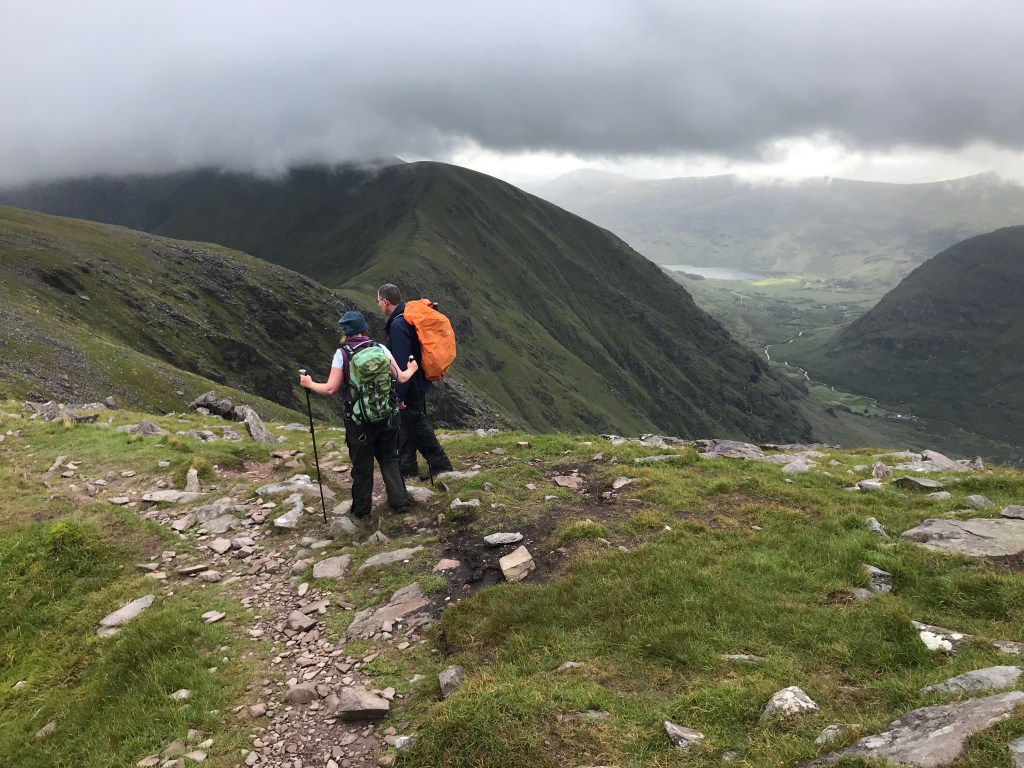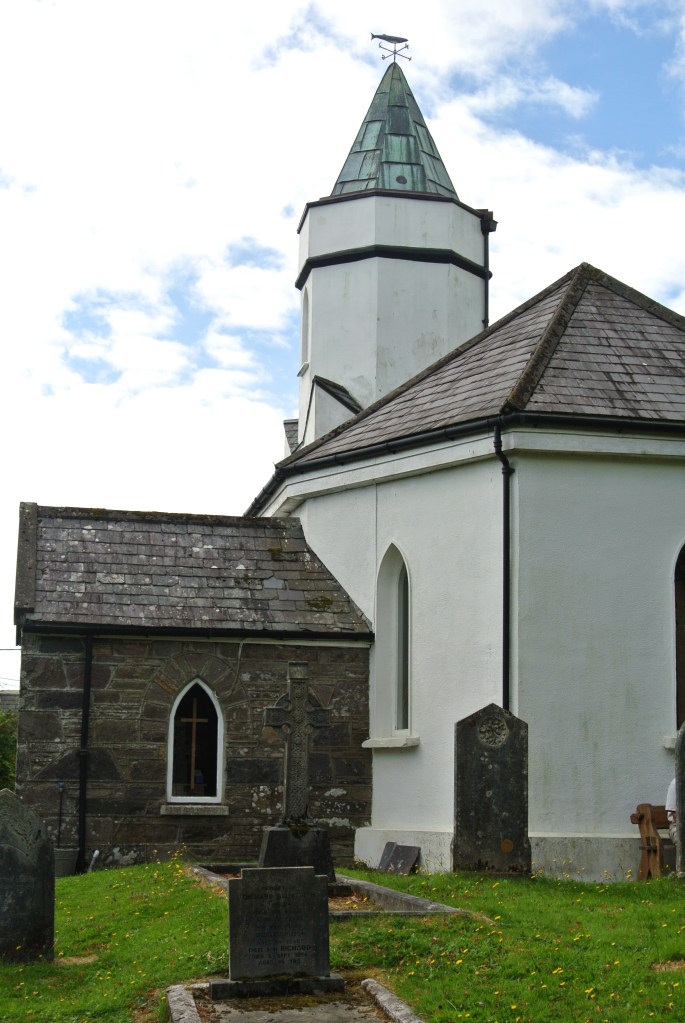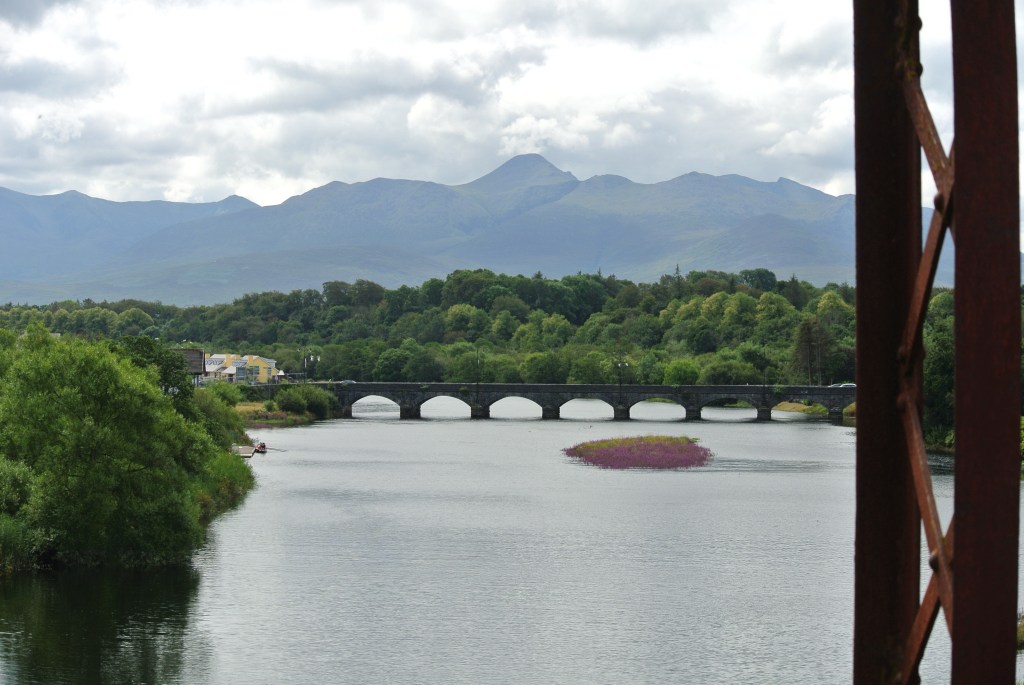
with my friends Simon and Michelle. August 2019
When I stood on the summit of Carrountoohil in August last year I was almost exactly midway between Killorglin, on the northern side of the Iveragh Peninsula, and Templenoe, on the southern side. Killorglin is a well known town on the Ring of Kerry, famous for its annual Puck Fair, while Templenoe, also on “The Ring” is less familiar. As the crow flies it is about 35 km from Killorglin on the north side to Templenoe on the south, but “the crow” would have to climb very high to get over the peaks of the MacGillicuddy Reeks: the summit of Carrountoohil is just over a thousand metres above sea level. By road the most direct route is over narrow local roads southward to Glencar then up over the Ballaghbeama Gap between Mullaghanattin peak and Lough Brin and down the other side to the Blackwater Bridge, just west of Templenoe, on the Kenmare River estuary. Driving this route today takes perhaps an hour, whereas from Killorglin to Templenoe around the western part of the Ring of Kerry takes several hours of driving. It is nevertheless the more popular route today, famed for its spectacular scenery. There are various walking tracks too, notably the Kerry Way, but walking over the mountains takes days rather than hours.

In 1858 an ancestor of mine, William Hickson, a nailor of Killorglin, married Mary Needham, spinster of Templenoe. Motor vehicles were unknown then, so they travelled on horseback, by “jaunting car” (pony or donkey and trap), or on foot. Although in today’s terms it was fairly close, in the 1850s it could be a difficult journey. I wonder which route they took? Did William ever walk directly over the Reeks through the inclement Kerry weather to see his sweetheart? Did either family own a horse? Did he hire a jaunting car to carry him over the mountains? His most likely route, perhaps, was the bigger road through Killarney, then south over Moll’s Gap to Kenmare, then westward to Templenoe. There was (and still is) also a spectacular route over the Gap of Dunloe, but mountain tracks could be difficult in bad weather, which is plentiful in Kerry, and there was little shelter on the way if a storm should descend from the mist covered heights.

I have wondered how William and Mary met. Both families were part of the minority Protestant population of Kerry, and I imagine that most of the Protestant families knew each other. Mary’s father was a parish clerk in Templenoe, and had previously been a captain in the Kerry coastguard. William’s father was a nailor, from whom William had learnt his trade. Both William’s and Mary’s mothers had died by the time the young couple married, so neither had the joy of seeing their respective children – the first Hickson son, and the first Needham daughter – tie the knot. Mary and William, both 25, were married in the little Church of Ireland church in Templenoe, a stone’s throw from the banks of the beautiful Kenmare River. It still stands, but like so many Church of Ireland buildings, is no longer a place of worship, but is privately owned.

Interestingly, William and Mary’s mothers had the same maiden surname, and it would not surprise me if they were related. William’s mother, Mary Ann Carter, died in 1853, at the age of 51, when the youngest of her seven surviving children was just five. Mary’s mother, Susan Carter, died in 1856 at the age of 38, after bearing ten children (she had Mary when she was 15!). If the two women were sisters (they were sixteen years apart, but it is still possible I suppose), it would make William and Mary first cousins. But they may have been more distantly related than that – I have not been able to trace the family connections. Interestingly, one of the witnesses at the marriage in Templenoe Church was Nathaniel Carter, no doubt a relative on one or both of the mother’s sides.

The couple may have got to know each other in Sneem, a village some ten miles to the west of Templenoe, also on the Kenmare River estuary. I believe William lived and worked there for some years after 1853, the year his mother had died, and his older sister had migrated to Australia. His widowed father, who was a nailor too, presumably went there with his oldest son, to work. William’s youngest brother, John, just five years old when his mother died, went with them, and possibly others of the Hickson siblings. Though some probably stayed in Killorglin, in the family home. There is some suggestion that young Mary had also found employment in Sneem during those years, so she may have caught William’s eye at the Church of Ireland church there, which would have been the main meeting place for all the Protestants in the area. This church, The Church of the Transfiguration, built in 1810, is one of the few COI churches in Kerry that still functions as a place of worship.

After their marriage, William and Mary presumably made their home in Killorglin, where William had grown up. Their first three children were born there, Richard in 1859, Susie (my great grandmother) in 1861 and Lizzie in 1863. Then in 1865 the whole family migrated to America, where another five children would be born. However, things did not go well for the Hicksons in America, and in 1877, lured by reports of better living and earning possibilities, they returned to the beautiful green valleys and hills of Ireland and migrated again, but this time to Sydney, Australia, where all William’s siblings had settled. Their children, all born in Ireland and America, lived the rest of their days under the sunny skies of the Southern Hemisphere. None of them ever saw Ireland or America again.

The MacGillicuddy Reeks are spectacular, brooding, wild peaks which form a massive barrier between Killorglin in the north and Templenoe in the south. It would have taken William two days to walk over the peninsula to see Mary. In a jaunting car he could have made the journey in a day. He would have walked or ridden over the ramparts of the very same mountains that my friend Simon, his wife Michelle and I climbed last summer, peaks with wonderful names like Skregbeg, Skregmore, Knockbrinnea, Caher, Curraghmore, Broaghnabinnia and Carrountoohil. I wonder if he, like me a century and a half later, often thought back to those mountains with longing.

William and Mary married in the little church in Templenoe in the autumn of 1858. I can imagine that the leaves were changing on the trees and the chilly winds of winter were blowing up the Kenmare River estuary from the Atlantic. They were both 25 years of age according to their marriage record. I wonder if they had an inkling of the life that lay before them, of the Christian revival that would change their lives just a few years later, of leaving their native land to migrate across the Atlantic to America with their little children, of twelve difficult years spent in their new country where more children would be born. Even if they already had thoughts of America on their wedding day, they could surely not have imagined that they would eventually end up in Australia, on the far side of the world, where they would spend the rest of their days. They lived in Summer Hill, and later in Arncliffe, in the young colonial metropolis of Sydney. William died in 1899, at the age of 66, but Mary lived on till 1916, the Irish matriarch finally laid to rest when she was 86. Both are buried in Woronora Cemetery in the southern suburbs of Sydney, far from the mountains of Kerry.

Hi David.
Another good read!
When I visited Kerry in 2015 I had forgotten it was the home of our Hickson forebears until I got home and Martin reminded me. While on the Ring of Kerry tour I was drawn to the CoI church in Sneem (and to the unusual name of the town) and spent a little time looking around the building and being intrigued by some of the plaques with their colonial and military references. I was delighted to read about JC’s connection through family holidays when I read his travelogue in full. Your historical imagination has added even more!
Thanks Peter. Historical imagination is what makes travelling so much fun. It’s amazing to think you were in Sneem and didn’t realise that your ancestor JCH lived there, and even went to the church you were looking around! I suppose you didn’t see the plaque he had placed in the church in Killorglin. He certainly wanted to leave his mark!
That was lovely to read David . You bring the past into the present .
Regards
Wendy Fitzgerald Williamson
Thanks Wendy. I suppose the past is always here in the present in some way, and maybe that is what family history is all about. I wish I had a photo of the young William and Mary. That would make them more real, but photos were not that common in the 1850s.
Although my relationship with the Hickson is very tenuous, and possibly not something about which the Hickson wish to brag, I really enjoy reading about them. Just think, if your great grandmother hadn’t married my great uncle our paths would probably never have crossed, nor would we be sharing our interest in family history. Thank you for sharing the Hickson line.
I’m glad our paths have crossed as a result of our ancestors antics. It’s been lots of fun to explore the past with you!